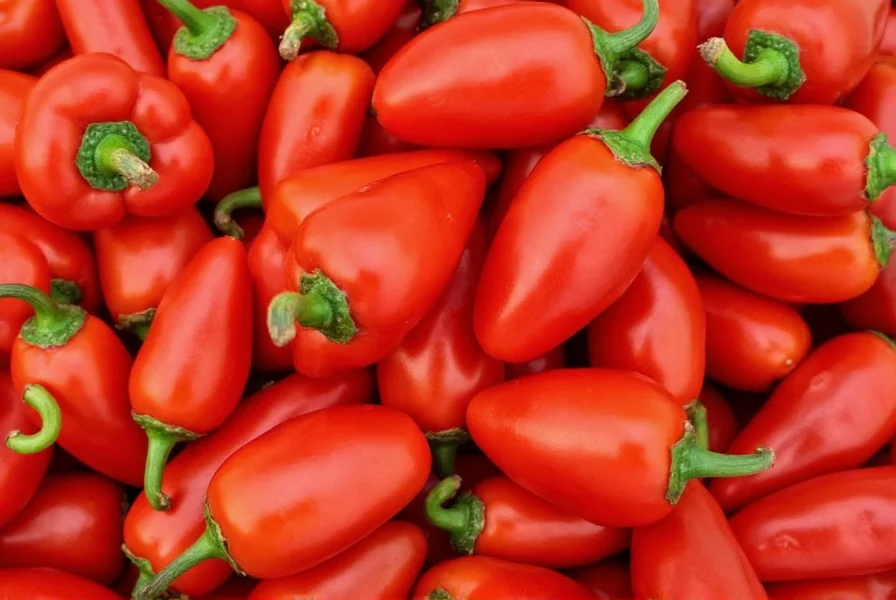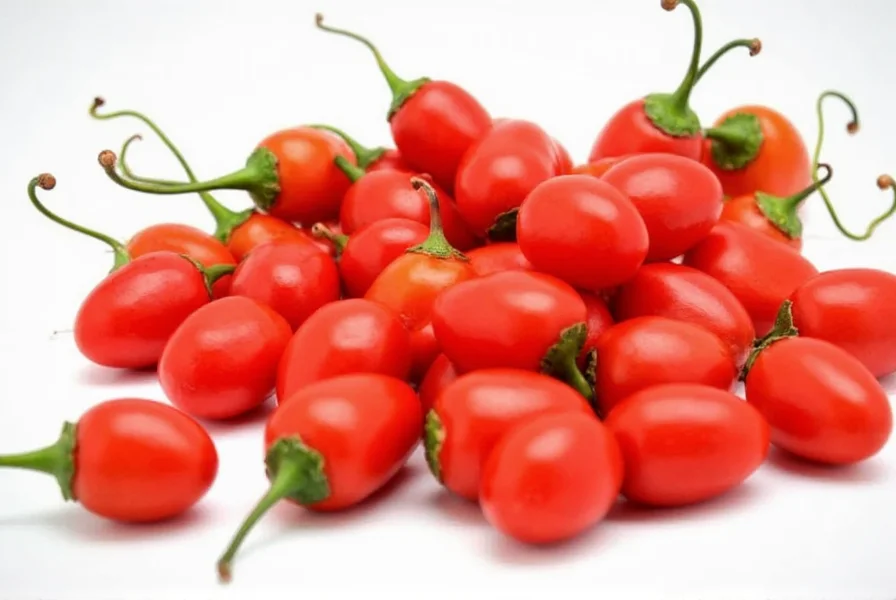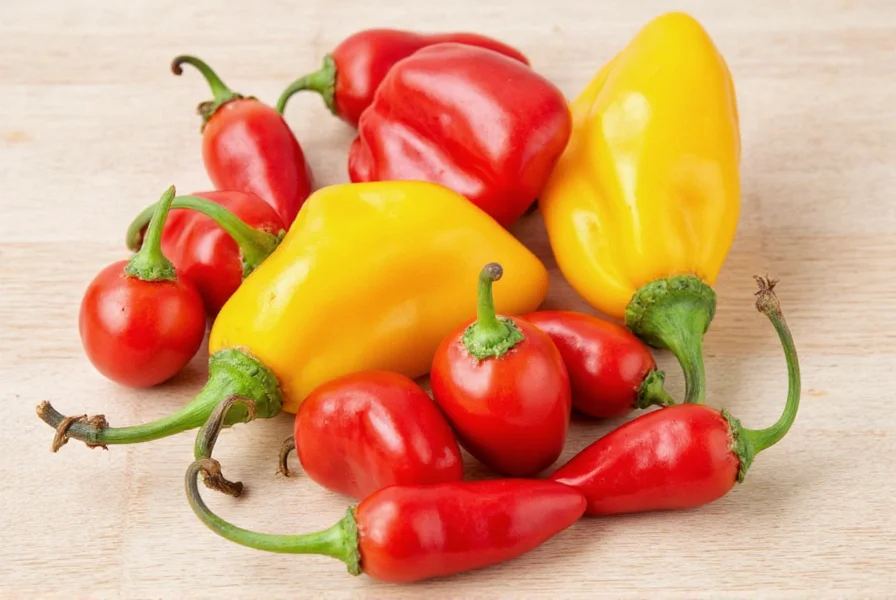Little round chili peppers are compact, potent varieties like Bird's Eye, Pequin, and Dundicut that deliver intense heat in small packages. These peppers typically measure 1-2 inches in diameter with Scoville ratings ranging from 1,000 to 150,000 units, making them essential for authentic Southeast Asian, Caribbean, and Latin American cuisines.
Types and Characteristics of Round Chili Peppers
Understanding the specific varieties helps you select the right pepper for your culinary needs. These small but powerful ingredients vary significantly in heat and flavor profiles.
| Pepper Variety | Origin | Heat Level (SHU) | Distinct Flavor Notes | Ideal Culinary Applications |
|---|---|---|---|---|
| Bird's Eye Chili | Thailand/Vietnam | 50,000-100,000 | Citrusy, sharp finish | Thai curry pastes, Vietnamese dipping sauces, Malaysian sambal |
| Pequin Pepper | Mexico/Texas | 40,000-60,000 | Floral, nutty complexity | Mexican mole sauces, Yucatecan recados, artisanal hot sauces |
| Dundicut Chili | Caribbean | 100,000-150,000 | Smoky, earthy depth | Jamaican jerk seasoning, Trinidadian pepper sauce, Caribbean stews |
| African Bird's Eye | Central Africa | 100,000-175,000 | Clean, immediate heat | African stews, peri-peri sauce, grilled meat rubs |
| Malagueta Pepper | Brazil | 60,000-100,000 | Fruity, tropical notes | Brazilian moqueca, pimenta malagueta sauce, seafood dishes |
Understanding Heat Levels and Practical Handling
Round chili peppers contain capsaicin concentrated in the placental membranes and seeds. Their small size doesn't indicate mildness—many deliver surprising heat that requires careful handling.
Key Factors Affecting Heat Intensity
- Color maturity: Red variants typically measure 20-30% hotter than green counterparts
- Geographical origin: Same varieties grown in different regions can vary significantly in SHU
- Storage conditions: Refrigeration preserves capsaicin levels better than room temperature
Professional Handling Techniques
- Use nitrile gloves (latex doesn't block capsaicin)
- Work in well-ventilated areas to avoid airborne irritation
- Neutralize accidental contact with dairy-based solutions (milk, yogurt)
- Remove only partial seeds/membranes to control heat levels precisely
Advanced Culinary Applications

Professional chefs leverage round chili peppers' concentrated flavor through specialized techniques that maximize their culinary potential while controlling heat distribution.
Expert-Level Usage Methods
- Infused Vinegar Base: Steep whole peppers in 5% acidity vinegar for 2-3 weeks to create versatile heat foundation
- Flash Roasting: Briefly char peppers under broiler to develop complex caramelized notes without diminishing heat
- Layered Heat Technique: Combine multiple chili varieties at different preparation stages for multidimensional spice
- Oil Suspension Method: Create chili oil with precise heat control by monitoring oil temperature (180-200°F optimal)
- Freeze-Dried Powder: Preserve volatile flavor compounds while extending shelf life up to 2 years
Purchasing and Quality Assessment Guide

Selecting premium quality round chili peppers requires attention to specific visual and tactile indicators that differentiate exceptional specimens from average produce.
| Quality Indicator | Superior Specimen | Substandard Specimen | Practical Testing Method |
|---|---|---|---|
| Surface Texture | Glossy, taut skin | Dull, wrinkled appearance | Light squeeze should produce slight resistance |
| Color Uniformity | Vibrant, consistent hue | Yellowing or dark spots | Hold against white background for true color assessment |
| Stem Condition | Firm, green attachment | Shriveled or blackened | Gentle tug should require moderate resistance |
| Aromatic Profile | Pungent, clean scent | Musty or fermented odor | Crush tiny piece to release essential oils |
| Weight-to-Size Ratio | Substantial heft | Surprisingly light | Compare multiple specimens of identical size |
Precision Storage Methods for Maximum Freshness
Proper storage techniques significantly extend the usability of round chili peppers while preserving their volatile flavor compounds and capsaicin content.
Optimal Storage Protocol
- Short-term (up to 3 weeks): Perforated plastic bags in vegetable crisper at 45-50°F (7-10°C) with 90-95% humidity
- Medium-term (2-6 months): Vacuum-sealed whole peppers frozen at 0°F (-18°C) without washing
- Long-term (1+ year): Dehydration at 125°F (52°C) until brittle, then stored in oxygen-absorbed glass containers
Heat Preservation Metrics
- Refrigeration maintains ~95% capsaicin content for first 2 weeks
- Freezing preserves ~92% heat intensity for 4 months
- Dehydration concentrates heat by 15-20% while extending shelf life
- Canning reduces heat intensity by 30-40% due to thermal degradation
Expert-Verified Frequently Asked Questions
Which little round chili peppers are actually spherical versus oval-shaped?
True spherical varieties include the African Bird's Eye (Piri Piri) and some Thai Krchee varieties. Most "round" peppers like Pequin and Bird's Eye are technically oval but appear round due to their short length-to-width ratio (typically 1.2:1 to 1.5:1). The Malagueta pepper maintains the most consistent spherical shape among commonly available varieties.
How do I accurately measure the heat of fresh round chili peppers at home?
While professional Scoville testing requires laboratory equipment, home chefs can use the "taste progression" method: finely mince a small piece, mix with 1 tsp neutral oil, then gradually add to 2 tbsp plain yogurt while tasting after each addition. Note when heat becomes noticeable (mild), pronounced (medium), and overwhelming (hot). Compare to known references like jalapeño (noticeable at 1/8 tsp) for relative measurement.
What's the science behind why small peppers are often hotter than larger varieties?
Evolutionary biology explains this phenomenon: smaller peppers have higher surface-area-to-volume ratios, requiring more capsaicin to deter predators effectively. The placenta (seed-bearing membrane) constitutes a larger percentage of the fruit's mass in small peppers, concentrating heat-producing capsaicinoids. Research published in the Journal of Agricultural and Food Chemistry (2024) confirmed that Capsicum frutescens varieties (including most round chilies) produce 2-3 times more capsaicin per gram than larger Capsicum annuum varieties.
Which round chili varieties offer the best flavor-to-heat ratio for everyday cooking?
For balanced culinary performance, Bird's Eye chilies provide the optimal flavor-heat ratio with their citrusy notes enhancing rather than overwhelming dishes. Pequin peppers offer complex floral notes at moderate heat levels (40,000-60,000 SHU), making them ideal for subtle heat enhancement. The Brazilian Malagueta stands out for its tropical fruit notes that complement seafood and poultry while delivering substantial heat (60,000-100,000 SHU).
How can I grow authentic round chili peppers that match commercial quality?
For authentic results, use heirloom seeds from region-specific cultivars (Thai Krchee for Bird's Eye, Tabasco for African varieties). Maintain soil pH between 6.0-6.8 with high potassium content. Implement controlled drought stress during flowering (reduce watering by 30% for 10 days) to boost capsaicin production. Harvest when peppers detach easily with gentle pressure, indicating full maturity and peak flavor development.
What are the most common substitution mistakes when using little round chili peppers?
Chefs frequently err by substituting round chilies one-to-one with elongated varieties like jalapeños, not accounting for the 3-5x higher heat concentration. Another common mistake is using dried substitutes without adjusting for the 8-10x heat concentration in dehydrated peppers. The most critical error involves ignoring flavor profile differences - Bird's Eye's citrus notes don't substitute well for Pequin's nuttiness in complex sauces.
Professional Recommendations for Culinary Implementation

Master chefs emphasize timing and preparation methods when working with little round chili peppers. Add minced peppers during the final 5-7 minutes of cooking to preserve volatile flavor compounds. For layered heat effects, introduce whole peppers early in the cooking process and minced peppers later. When making emulsified sauces, process peppers with a small amount of neutral oil first to evenly distribute capsaicin. Always taste test incrementally—these concentrated peppers can transform a dish's heat profile with just a few extra seeds.
Understanding the specific characteristics of each round chili variety allows precise heat and flavor control. By matching pepper types to culinary applications and implementing proper handling techniques, home cooks can achieve restaurant-quality results with these potent ingredients.










 浙公网安备
33010002000092号
浙公网安备
33010002000092号 浙B2-20120091-4
浙B2-20120091-4